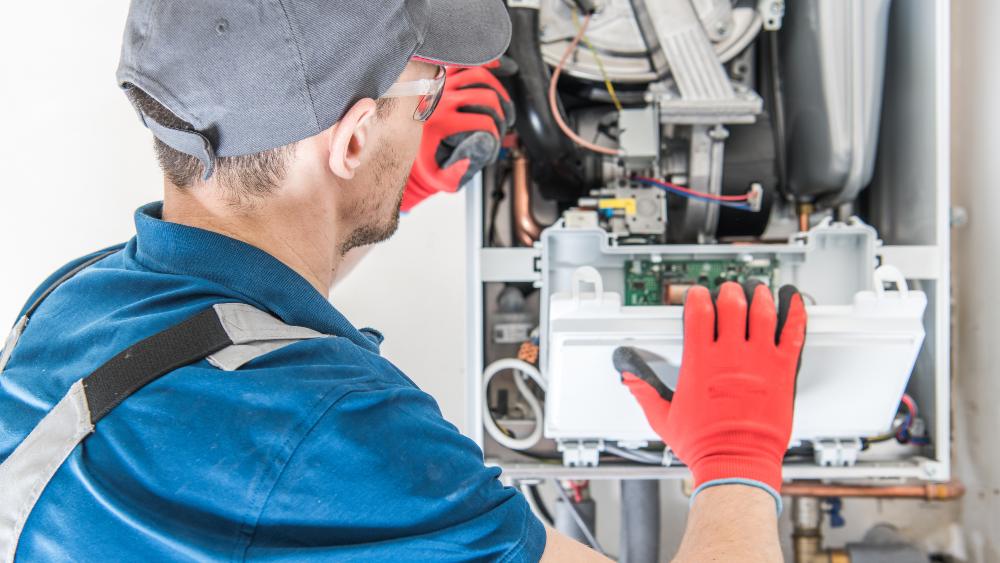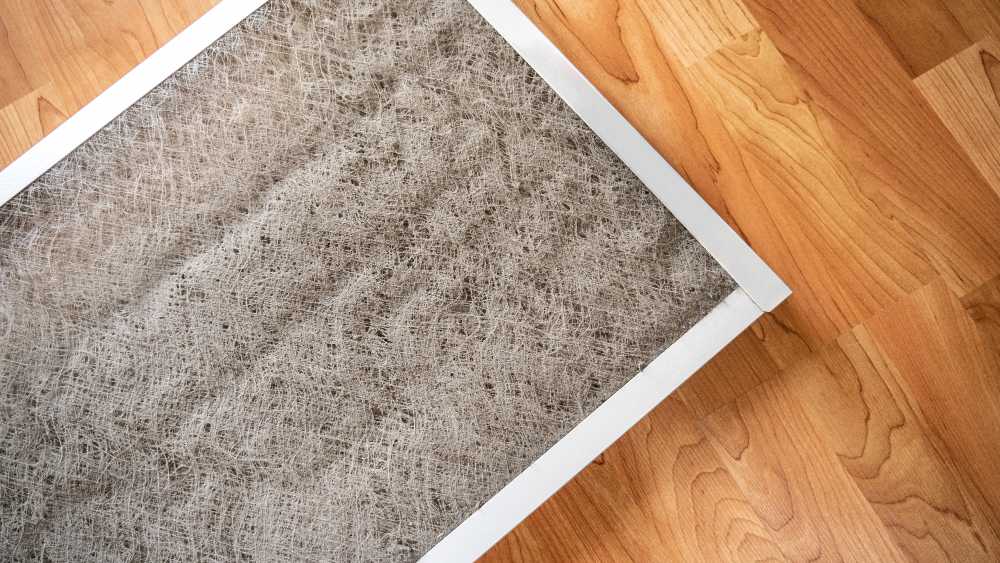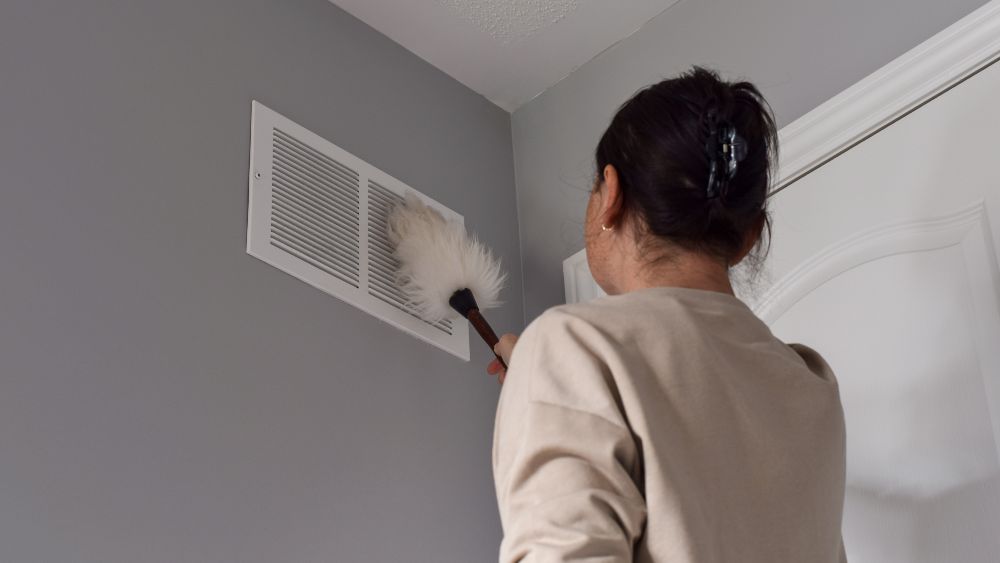
Key Takeaways
- If the pilot light is out or the ignition system is faulty, the furnace won’t produce heat.
- Clogged filters restrict airflow, causing the furnace to overheat and shut down.
- Focus on regular furnace maintenance to ensure efficient operation.
As the mercury drops, your furnace becomes an essential part of keeping you warm and cozy. However, when your furnace stops blowing hot air, it can be both frustrating and concerning. The good news is that before contacting a professional, there are several simple solutions you can try to resolve the problem.
This post will explore the top reasons why your furnace is not blowing hot air and effective troubleshooting methods you can use to address these issues. Whether it’s simple tasks like unclogging vents, inspecting filters, or tackling more serious issues like overheating furnaces, this comprehensive guide has got you covered.
- 1. Incorrect Thermostat Settings
- 2. Wrong-Sized Furnace
- 3. Dirty Air Filters
- 4. Furnace Takes Time to Heat
- 5. High-Limit Switch Failure
- 6. Clogged Condensate Line
- 7. Insufficient Fuel
- 8. Leaky Ducts
- 9. Pilot Light Is Out
- 10. Blocked Burner
- 11. Dirty Flame Sensor
- 12. Furnace Is Overheating
- 13. Gas Valve Issues
- 14. Faulty Circuit Board
- 15. Clogged Vents
- 16. Ductwork Isn’t The Right Size
- Should You Repair or Replace Your Furnace?
- Troubleshooting A Malfunctioning Furnace
There are many reasons why your furnace might not be blowing hot air. Read on to discover the possible furnace problems and how you can overcome them.
1. Incorrect Thermostat Settings
When it comes to diagnosing issues with your furnace, it can be easy to jump to more complex solutions while overlooking the simplest one: the thermostat.
Sometimes, the switch of a manual thermostat can be turned off during the cleaning process. Or someone in your household may have accidentally adjusted the temperature or fan settings.
If you have a battery-operated thermostat and the batteries are dead, it could also cause your furnace to blow cold air. Look out for a blank thermostat screen, as this may indicate that your batteries need to be replaced.
Proper thermostat installation is highly important. If the thermostat is not wired correctly or is incompatible with your HVAC system, it can cause significant problems. Also, the location of the thermostat can greatly impact its readings, so it is important to avoid direct sunlight and drafty areas.
Solution:
- Make sure your thermostat is set to heat and the desired temperature is set above your home temperature, usually above 68F. Also, check the fan settings. If it is set to ‘on’, this can cause the fan to blow air continuously without any heat from the furnace. Switch the fan to ‘auto’ to allow your system to blow air only when the furnace produces heat. Alternatively, you can also invest in a smart thermostat to enjoy efficient climate control with automated fan settings.
- Check your thermostat batteries. If they are weak or have died, replace them to restore your thermostat functioning.
- If you have recently installed your thermostat, have a technician come over to check the thermostat wiring.
Equip your HVAC system with smart features and achieve the perfect balance between comfort & savings.
Learn more
2. Wrong-Sized Furnace
When purchasing a new furnace, you must consider its size before making your final decision.
If your furnace is not blowing hot air, then it might be too small for your home. A furnace that is too small may struggle to measure your home’s internal temperature accurately, resulting in the circulation of cool air.
On the other hand, an oversized furnace may frequently turn on and off. Understanding the intricacies of furnace sizing is crucial for achieving optimal performance, especially as the colder months approach.
Solution: Get an HVAC professional to do a manual J calculation of your home. This formula helps identify the HVAC capacity of a building and the correct size of equipment you’re installing for your home.
3. Dirty Air Filters

Your furnace relies on a clean air filter to operate efficiently. If you last replaced your air filter quite some time ago, this could be the root cause of many furnace issues. Over time, debris, dust, and allergens accumulate on the filter surface, ultimately causing it to clog and impede the flow of air.
This causes the furnace to overheat, which is why it blows cold air to cool itself.
Solution: To resolve this issue, check your air filter for dirt and debris. Hold it up to the light to see if you can detect any light shining through. If not, it’s time to change it. Many HVAC specialists recommend replacing your filter every three months as it helps cut back on your heating bills; however, if your home sees a lot of traffic or has pets, consider increasing the frequency.
Here’s all you need to know about furnace maintenance.
4. Furnace Takes Time to Heat
It’s common to want your furnace to start blowing hot air immediately, especially during freezing weather. However, it’s important to note that, like any other heating system, furnaces need a bit of time to begin functioning properly.
Generally, it takes around 15 minutes for the furnace to start distributing hot air after it has been turned on. Don’t worry if you experience cold air when you first turn on the furnace – this is perfectly normal.
While it may be tempting to fiddle with the thermostat or try to speed up the process manually, it’s best to let the furnace do its job and deliver the heat at its own pace.
Solution: If your furnace still doesn’t blow warm air after some time, then it’s best to call an HVAC professional to check out the underlying issue.
5. High-Limit Switch Failure
The high-limit switch is a crucial safety feature for furnaces. Its purpose is to automatically shut off the gas supply if the burner temperature exceeds the safe range.
Your furnace can overheat if the airflow is restricted due to a dirty air filter or blocked vents. This causes the high-limit safety switch to break down. When this happens, your HVAC gets a signal that the furnace is overheating, so it shuts down and stops blowing hot air.
Solution: It is recommended that you call an HVAC technician to replace the broken high-limit switch, as it might be dangerous for you to do it yourself. After all, furnaces operate on high-voltage electricity and contain flammable gas or oil.
However, if you have a basic understanding of electrical components and know how to use a multimeter, you can attempt the replacement yourself. Start by disconnecting and removing the faulty switch. Test the switch using a multimeter to see if it has continuity. If the multimeter shows infinite resistance, it means the switch is defective. In this case, replacing the limit switch is a simple process: insert a new switch, secure it with the mounting screws, and reconnect the wires. It is important to buy a limit switch that matches the specifications of the original switch, including voltage ratings and temperature range.
6. Clogged Condensate Line
The condensate line is responsible for draining the water from your HVAC system, and it must remain clean at all times. If it becomes clogged because of dirt accumulation, it can trip the safety switch in the furnace and prevent the burners from igniting, which results in cold air blowing.
Solution: Contact an HVAC technician for condensate line cleaning. They have specialized tools such as drain snakes, wet vacs, and high-pressure hoses that clear out any debris and buildup blocking your lines.
7. Insufficient Fuel
For a furnace to generate heat, it requires some form of fuel, whether that be oil, gas, or electricity. If your furnace lacks fuel, then it will not blow out hot air.
Solution:
- Oil-Furnace: Check the oil tank. If it’s empty, your unit can’t run. Make sure to keep it filled.
- Gas-Furnace: In case your gas furnace is not blowing air, you should ensure that the gas valve is open, as a closed valve will prevent your furnace from producing heat. Also, check to make sure that the gas tank is full.
- Electric Furnace: If your electric furnace isn’t blowing hot air, the first thing to check is whether it is receiving power. Make sure you don’t have a tripped circuit breaker or a burned fuse that may have cut off the power supply. According to Brad Roberson, President of Aire Serv, “If the power is restored and your electric furnace is still blowing cold air, then it may be because of the cool-down cycle. This cycle is designed to prevent the unit from overheating when power is suddenly restored. During the cool-down cycle, the fan runs to dissipate any remaining heat in the system, which can result in the emission of cool air.”
8. Leaky Ducts
The ductwork in your home serves as essential conduits for distributing hot air from the furnace throughout every room. However, over time, your air ducts can develop leaks, causing air to escape through these openings. What’s more, these leaks also allow for cold air to enter the vents, causing your unit to blow cold air into your living space. Not only can this make your home feel chillier than you’d like, but it can also lead to increased energy costs as your furnace works harder to keep up.
Solution: If you can access your ductwork, look for gaps and cracks between different duct sections. You can seal the holes using metal duct tape. Don’t use standard duct tape, as it will deteriorate quickly. For a thorough inspection, call an HVAC technician to inspect the gaps caused by disconnected ducts or damage to the ductwork resulting from incorrect installation.
9. Pilot Light Is Out
If you have an older gas furnace, it will have a pilot light similar to the one on a gas stove. This can get blown out due to several reasons. It can be put out accidentally during maintenance work, due to dirt accumulation or a thermocouple failure.
Solution: Check the pilot light or ignition system for any issues. Make sure the pilot light is free of dirt that could prevent it from igniting the gas. Cleaning the pilot light can improve gas flow and restore your system’s performance.
To safely relight the pilot light, consult your furnace manual for detailed instructions. It’s important to note that if the pilot light keeps going out, the problem could be a faulty thermocouple. These repairs are usually intricate and not recommended for DIYers. It’s best to reach out to an HVAC professional for assistance with this particular issue.
10. Blocked Burner
The furnace burners can become clogged due to a lack of maintenance, which can hinder the flow of fuel, preventing ignition. However, this does not affect the fan, and it continues to blow cold air throughout your home.
Solution: Contact an HVAC expert to clean your burner and prevent any future issues.
11. Dirty Flame Sensor
The flame sensor is another gas furnace component that can become coated with dirt and grime or simply wear out if you neglect regular maintenance. This can be a problem because a damaged flame sensor will trigger an automatic furnace shutdown.
Solution: To clean the sensor, turn off the power to the furnace and shut down the gas supply to the unit. The flame sensor is a thin, metallic road, and you can find it on or near the burner assembly. Carefully clean it using an emery cloth or a soft brush. Refrain from over-scrubbing it, as it can cause more issues.
If you notice that the flame sensor has been damaged, contact a furnace repair specialist for replacement.
12. Furnace Is Overheating
If your furnace is not blowing hot air, then it might be overheating. There are several reasons why this happens:
- A clogged filter often causes the system to work harder to maintain your home temperature, resulting in overheating.
- Your furnace’s performance will start to deteriorate as it gets older. You may notice it’s overheating and blowing out cold air. On average, a furnace lasts about 20 years. However, if you do not follow preventive maintenance guidelines, it can start having issues early on and may not even pass the decade mark.
- Loose wiring, for instance, is a common culprit that can cause the furnace to overheat and stop functioning.
Solution: Call a professional to diagnose the exact issue.
13. Gas Valve Issues
Regular cleaning is crucial to keep gas furnaces running smoothly. Debris buildup can cause the gas valve to shut down or malfunction. Also, wear and tear on the gas valve can lead to the furnace blowing cold air.
Solution: By scheduling routine furnace maintenance, you can prevent these problems and ensure that your system operates efficiently.
14. Faulty Circuit Board
The furnace circuit control board communicates with various components to carry out various tasks. When it receives the heating command from the thermostat, it sends the signal to turn on the furnace blower and burner.
However, if the circuit control board is not working properly, it may turn on the blower but fail to engage the burners, resulting in no heat being generated.
Solution: Contact an HVAC technician to replace the faulty circuit control board and find out what exactly caused this issue. Sometimes, your furnace starts leaking water, and that can drip on your circuit control board. This can corrupt the control board and damage its components.
15. Clogged Vents

If your furnace is running but not blowing any hot air, then it may be because your return vents are blocked. Return vents serve a crucial role in your home’s heating system by bringing in air from your living space and channeling it to the furnace for heating.
However, obstructions such as furniture in front of your vents can impede this process, depriving the furnace of the essential air it needs. As a result, the furnace will circulate cold air instead of warm air, leaving your home chilly.
Solution: Check all the air vents in your home and remove obstructions in front of them.
16. Ductwork Isn’t The Right Size
It is vital to ensure that the ductwork is properly sized to optimize heating performance and maintain a comfortable environment in your home.
If the return ductwork is too small, it won’t be able to handle the required volume of air. This restriction leads to reduced airflow through the system, causing the furnace to blow cold air. If your ducts are too big, the air pressure will significantly decrease, and the hot air won’t reach your home.
Solution: Consult with your local duct installer to get your ductwork checked.
Should You Repair or Replace Your Furnace?
When deciding between the cost of a new furnace and repairing an existing one, it’s crucial to consider the age, efficiency, and condition of the current unit. If the furnace is relatively new and the repairs needed are minor, opting for repairs may be the more economical choice.
However, if the existing furnace is approaching the end of its lifespan, is inefficient, or requires frequent and expensive repairs, it makes more financial sense to invest in a new furnace. Also, if a repair costs 30% or more of the original price, it’s recommended to opt for furnace replacement.
Although a new furnace has a higher upfront cost, the long-term benefits of energy savings, improved efficiency, and potentially lower maintenance expenses make it a more cost-effective and reliable option in the long run.
Related: Stay on Top of Your HVAC Maintenance Needs in 2023
Troubleshooting A Malfunctioning Furnace
Many different issues can cause a furnace that is not blowing hot air. From basic problems like dirty filters or incorrect thermostat settings to more complicated things like broken igniters or high-limit switch failure. Some of these heating problems you can fix yourself, like changing air filters and changing thermostat batteries. Other problems, like replacing the faulty control board or cleaning the burners, require professional assistance.
Regular maintenance is key to preserving your furnace’s lifespan and ensuring that it operates at its peak performance during the heating season. To ensure a comfortable temperature in your home and prevent potentially costly repairs, make sure to take the time to maintain and inspect your furnace on a regular basis.








